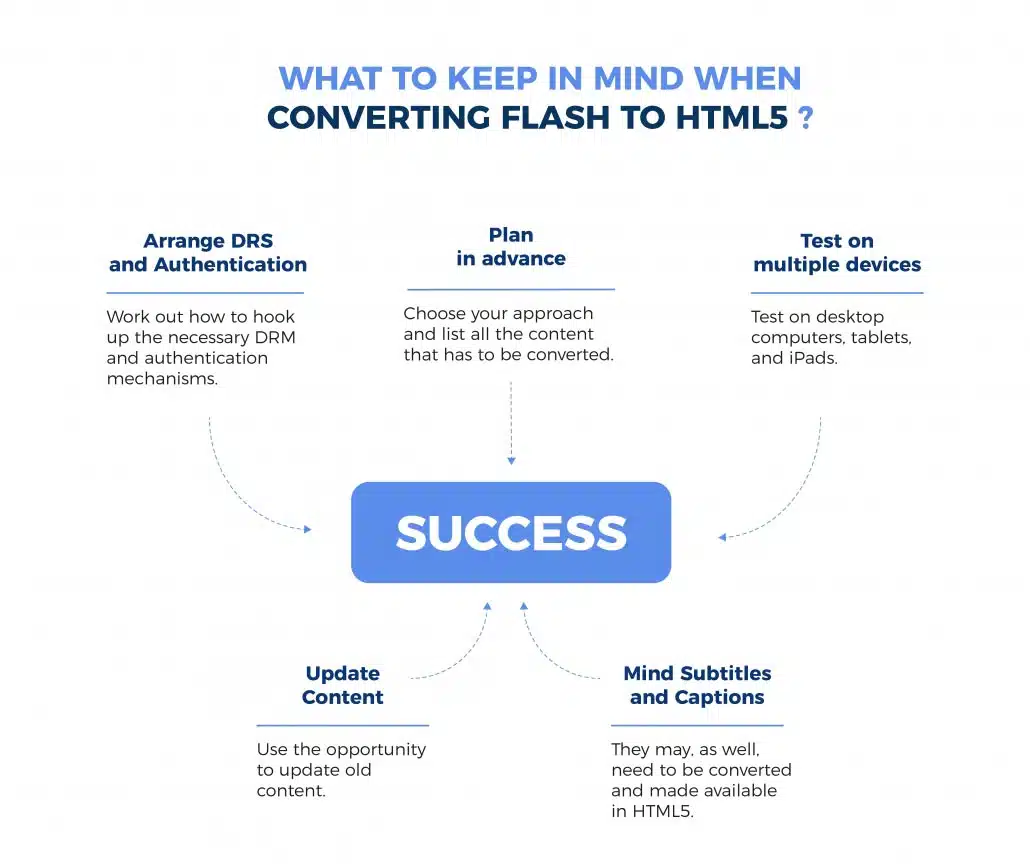Table of Contents
During the last decade, our business world has changed significantly due to smartphones and tablets taking over our professional environment.
As a business owner, you have probably already realized the importance of making your website faster, more secure, mobile responsive, and SEO friendly – these factors have become a must for ensuring a sustainable business. If your website or web app is Flash-based, an important step in this direction is the decision to convert from Flash to HTML5.
Converting websites from Flash to HTML5 has become a hot topic in tech forums over the past few years and the process of migration has become a priority for most companies. Choosing the right technology to support your website’s files is not only important for your company’s image but it is also directly related to user experience. The initial effort of converting will pay off and, in the long run, you will have a better performing website. Take a look at what your business could gain by converting Flash to HTML5 and which are the things you need to have in mind before you start.
Steps to Successfully Convert Flash to HTML5
To help you with this initiative, we’ve prepared some steps from our experience to help you get started and ensure a successful transition. They can be used as the first discussion points when you start considering the migration within your company.
-
Plan in advance
The transition could take up to a few months depending on the amount of content you have to convert. So it’s a good idea to have the detailed plan prepared in advance to be able to start with the actual work. This will reduce the stress from discovering more items coming up and you’ll be able to scope the initiative properly.
-
Pay attention to subtitles and captions.
Keep in mind that there are multiple types of visual content. Just as audio and video may need transcoding for the web, subtitles and captions may as well need to be converted and made available in HTML5.
-
Never miss an opportunity to update.
Going through your whole content online is an amazing opportunity to update outdated content, correct mistakes, repurpose webpages, revive articles and optimize your messaging. If you combine these activities you will double the benefits and the result will be a renovated web presence.
Take into account the Digital Rights Management guidelines. If your media requires authentication or special rights to be accessed, you’ll need to work out how to hook up the necessary DRM and authentication mechanisms. It’s always better to think it through in advance in order to provide your users with the best possible experience.
-
Test on multiple devices, including desktop computers, tablets, and iPads
One of the worst things that could happen to your brand online is broken pages or content that is not loading–as it could result in losing leads. Before launching everything, make sure that you’ve tested how the website will look on all devices.
Two Ways to Approach the Technical Side
There are two ways to approach converting Flash to HTML5 and choosing the right approach is crucial for the overall success of the initiative and the value it would bring to your business. Before you begin, you need to keep in mind that there are two types of Flash apps – one developed with Adobe Flash Professional, and one developed with Flex SDK.
For websites and web applications developed with Adobe Flash Professional, we can use Adobe Animate to convert it to HTML5 and then adjust the JavaScript files to make it work correctly. This is a quick approach, however, no framework is implemented on the HTML5. The HTML5 app is a converted version of the original Flash app. This approach to converting Flash to HTML5 is only used if the framework and expansion in the future are not prioritized because the conversion time can be fast, but the expansion time is limited. If you want to control the framework and also any expansion of the app in the future, it’s best to choose to rewrite the app with an HTML5 framework – the selected framework is usually Angular or React but this is also the approach for apps developed with Flex SDK. The time to rewrite an app is longer than converting with Adobe Animate, but with this approach, we control the framework and can easily expand the app in the future to add new features.
Benefits When You Convert Flash to HTML5
Still not convinced about converting to HTML5? If you haven’t seen already, there is a wide discussion online about Flash vs HTML5 and different opinions on their strengths and weaknesses. However, there are some unbeatable advantages HTML5 has over Flash.
-
Speed
First of all, Flash was never designed to be a primary tool for visual content. With our online world becoming more and more interactive, a request to update Flash Player could easily make users exit the website and never return again. This means that just by optimizing websites to load content quickly, we could reduce the bounce rates. Moreover, HTML5 consumes fewer resources and power than Flash. It is supported natively by the browser, while we need to install an additional plugin to load the Flash content.
-
Accessibility
HTML5 will not only make your website faster but also more accessible, allowing your users to reach it on any device. Moreover, as HTML5 allows live streaming, it will give you the opportunity to bring your audience to the first row of your activities, an advantage you cannot afford to lose in the 21st century. Flash will not be supported anymore in the near future, while HTML5 is supported by all browsers from desktop to mobile.
-
Security
In terms of security, Flash’s plugins hide greater risks and potential vulnerabilities for the user. Thus converting from Flash to HTML5 will be a win-win strategy for both your business and your audience. Due to the end of Flash support, recent security issues have not been fixed in Flash. With HTML5, the support is very active and any security issue is usually fixed in a few days.
-
Advertising
Last but definitely not least, come the ads. According to eMarketer’s forecast this year, digital advertising will overtake spending on traditional ads. If you want to ensure that your ads are compatible with all devices and load smoothly for your users, HTML5 is the answer. Rich media mobile ads incorporated in your content could drive more qualified leads into your sales funnel through higher click-through rates and you won’t be able to have them while still running on Flash. Moreover, HTML5 is friendly with SEO while Flash is not.
Conclusion
Being agile and adapting to the latest technology standards is no longer about innovation – it’s a must! By converting from Flash to HTML5 you will gain more speed, better accessibility, higher security and various opportunities for innovation. As it may seem a complicated process for most business owners and managers, we have compiled some practical advice to guide you to a successful transition. Adobe Flash has already announced it’s completely going away by early 2020 and, better yet, support will stop after December 2020! If you have been putting off converting from Flash to HTML5, this is the right time to get it done.






